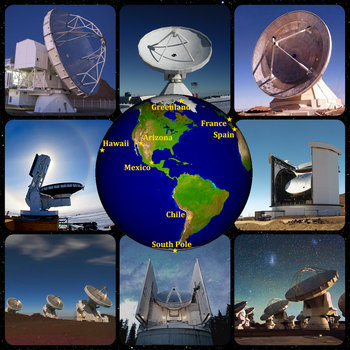

The EHT is globe-spanning VLBI array that observes the nearest supermassive black holes in Sgr A* and M87 at 1.3 mm wavelength. After years of preparation the EHT observed Sgr A* and M87 with telescopes around the world in the spring of 2017, 2018, 2021 and 2022.
By correlating the recorded electric field measured simultaneously at telescopes around the world, the EHT can effectively synthesize the resolving power of an Earth-sized telescope with an angular resolution of about 10 microarcseconds (1 / 360000000th of a degree!) Both because EHT measurements are sparse and because absolute phase calibration at millimeter wavelengths is impossible, recovering an image from EHT observations is a difficult and ill-posed problem. Images must be reconstructed using algorithms that find the best-fit images to data under a (hopefully minimal) set of additional assumptions about the source structure.

ehtim from realistic simulated data similar to the EHT’s observations in 2017. The circle at the lower right represents the EHT’s effective resolution
New Techniques for Imaging in Interferometry
As a leading member of the EHT’s imaging team, I develop new imaging methods that push the EHT’s imaging capabilities to higher fidelity and resolution. I have developed algorithms that bypass traditional self-calibration both for total intensity (Chael+ 2018) and polarization (Chael+ 2016). In Chael+ 2023, I extended the regularized maximum likelihood imaging technique to recover multi-frequency imgages and spectral index maps from simulated EHT data and real VLBA and ALMA datasets.
The First Black Hole Images
In April 2019, we published the results of our observations of M87; the first images of a supermassive black hole with resolution on event-horizon scales (read the papers). After devoting significant effort to overcoming the rapid variability in the Galactic Center observations, we published corresponding images of Sgr A* in 2022. After these initial images were released, I co-led projects to image and interpret linear and circular polarization data from the EHT, which directly constrain the magnetic field structure near the event horizon.
eht-imaging: a community tool
My software library eht-imaging has become a standard tool across the collaboration for imaging and analyzing EHT data (click here for more information). eht-imaging has been essential for producing the first EHT images at micro-arcsecond resolution of M87 in total intensity and polarization, in Sgr A*, Centaurus A, 3C279, and J1924-2914. eht-imaging is aso used for data analysis in interferometry beyond the EHT, including to make high-resolution images from RadioAstron the VLBA the GVA and VGOS Geodesy observations.

ehtim using an imaging algorithm robust to errors in amplitude and phase calibration (Chael+ 2018).